skip to main
|
skip to sidebar



Freq. 15690 Khz/Moldavia

Freq. 7190 Khz/Tunisia

Freq. 9665 Khz/Hungary

Freq. 11665 Khz/S. Gabriel

Freq. 6180 Khz/Japan

Freq. 6115 Khz/Albania

Freq. 9780 Khz/Saudi Arabia

Freq. 9680 Khz/Thailand

Freq. 9380 Khz/Philippines

Freq. 9500 Khz/Swaziland

Wideband omni-directional Discone antenna (with wide-frequency coverage VHF/UHF scanners and receivers, the Diamond D130J Discone consists of 16 rugged, stainless steel elements and is capable of transmitting up to 200 watts in the amateur 50, 144, 220, 432, 900, and 1200 MHz bands).Omni-directional for continuous 25-1000 MHz

Type:
HF/VHF/UHF receiver/scanner
Frequency range:
0.1-2600 MHz20/100/500 Hz and 1/5/6.25/9/10/12.5/20/25/50/100/500 KHz steps
Mode:
AM/NAM/WAM/NFM/WFM/SSB/CW
Sensitivity:
AM (10 dB S/N)0.2-0.5 MHz: 10.8 uV0.5-1.8 MHz: 4 uV1.8-4 MHz: 2.5 uV4-30 MHz: 1.1 uV
NFM (12 dB SINAD)28-30 MHz: 0.35 uV30-2000 MHz: 0.45 uV2000-2600 MHz: 0.8 uV
WFM (12 dB SINAD)30-2000 MHz: 1.5 uV
SSB/CW (10 dB S/N)0.2-0.5 MHz: 4.8 uV0.5-1.8 MHz: 1 uV1.8-4 MHz: 0.6 uV4-30 MHz: 0.3 uV30-2000 MHz: 0.3 uV2000-2600 MHz: 0.5 uV
User manual and Schematics:
http://www.rigpix.com/yaesu/vr5000.htm
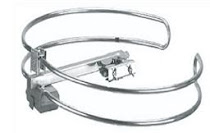
Circular Omnidirectional dipole antenna of broadband of FM for the reception of signals in band II.

Dipolo Antenna - A dipole antenna, developed by Heinrich Rudolph Hertz around 1886, is an antenna with a center-fed driven element for transmitting or receiving radio frequency energy.
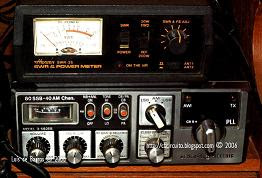
GE 3-5825B & Hansen SWR 3S
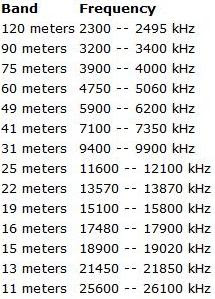

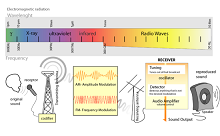
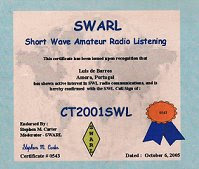

Shortwave listeners also collect QSL cards. Sometimes referred to as SWL cards, they can confirm reception of two-way amateur radio communications or commercial radio operators using HF frequencies. A more common form of QSL card for shortwave listeners to collect verifies the reception of signals from international broadcasting or utility stations.
Shortwave listening (abbreviated as SWLing) is the hobby of tuning for shortwave radio broadcasts located on shortwave frequencies, usually thought of as those from 1700 kHz (the upper limit of the AM broadcasting band) to 30 MHz
Click photo below for large version !


RADIO OF MOLDAVIA

Freq. 15690 Khz/Moldavia
TUNISIAN RADIO

Freq. 7190 Khz/Tunisia
RADIO BUDAPEST

Freq. 9665 Khz/Hungary
Radiodifusão Portuguesa Intl.

Freq. 11665 Khz/S. Gabriel
NIPPON HOSO KYOKAY

Freq. 6180 Khz/Japan
RADIO TIRANA

Freq. 6115 Khz/Albania
SERV. OF THE KINGDOM OF SAUDI ARABIA

Freq. 9780 Khz/Saudi Arabia
NBS OF THAILAND

Freq. 9680 Khz/Thailand
Philippines Broadcasting Services

Freq. 9380 Khz/Philippines
TRANS WORLD RADIO

Freq. 9500 Khz/Swaziland
ANTENNAS

Wideband omni-directional Discone antenna (with wide-frequency coverage VHF/UHF scanners and receivers, the Diamond D130J Discone consists of 16 rugged, stainless steel elements and is capable of transmitting up to 200 watts in the amateur 50, 144, 220, 432, 900, and 1200 MHz bands).Omni-directional for continuous 25-1000 MHz
EQUIPMENT YAESU VR 5000

Type:
HF/VHF/UHF receiver/scanner
Frequency range:
0.1-2600 MHz20/100/500 Hz and 1/5/6.25/9/10/12.5/20/25/50/100/500 KHz steps
Mode:
AM/NAM/WAM/NFM/WFM/SSB/CW
Sensitivity:
AM (10 dB S/N)0.2-0.5 MHz: 10.8 uV0.5-1.8 MHz: 4 uV1.8-4 MHz: 2.5 uV4-30 MHz: 1.1 uV
NFM (12 dB SINAD)28-30 MHz: 0.35 uV30-2000 MHz: 0.45 uV2000-2600 MHz: 0.8 uV
WFM (12 dB SINAD)30-2000 MHz: 1.5 uV
SSB/CW (10 dB S/N)0.2-0.5 MHz: 4.8 uV0.5-1.8 MHz: 1 uV1.8-4 MHz: 0.6 uV4-30 MHz: 0.3 uV30-2000 MHz: 0.3 uV2000-2600 MHz: 0.5 uV
User manual and Schematics:
http://www.rigpix.com/yaesu/vr5000.htm

Circular Omnidirectional dipole antenna of broadband of FM for the reception of signals in band II.

Dipolo Antenna - A dipole antenna, developed by Heinrich Rudolph Hertz around 1886, is an antenna with a center-fed driven element for transmitting or receiving radio frequency energy.
GE 3-5825B & Hansen SWR 3S
SWR & POWER METER
The SWR meter or VSWR (voltage standing wave ratio) meter measures the standing wave ratio in a transmission line. This is an item of radio equipment used to check the quality of the match between the antenna and the transmission line.
Schematic GE 3-5825B
http://photos1.blogger.com/x/blogger/3340/3157/1600/530617/5825Bschematic.jpg
Schematic GE 3-5825B
http://photos1.blogger.com/x/blogger/3340/3157/1600/530617/5825Bschematic.jpg
SINPO CODE EXPLAINED
S (Signal strength)
Simply the strength of the transmission.
I (Interference)
Interference from other stations.
N (Noise)
The amount of noise.
P (Propagation)
Whether the signal is steady or fades from time to time.
O (Overall merit)
An overall score for the listening experience under these conditions.
SINPO is a code used to describe the quality of radio transmissions, especially in reception reports written by shortwave listeners. Each letter of the code stands for a specific factor of the signal, and each item is graded on a 1 to 5 scale (where 1 stands for very bad and 5 for very good).
FREQUENCIES USED IN SHORTWAVE BROADCAST

PROPAGATION CHART

RADIO PROPAGATION
Radio propagation is a term used to explain how radio waves behave when they are transmitted, or are propagated from one point on the Earth to another.
In free space, all electromagnetic waves (radio, light, X-rays, etc) obey the inverse-square law which states that the power density of an electromagnetic wave is proportional to the inverse of the square of "r" (where "r" is the distance [radius] from the source) or:
Doubling the distance from a transmitter means that the power density of the radiated wave at that new location is reduced to one-quarter of its previous value.
The far-field magnitudes of the electric and magnetic field components of electromagnetic radiation are equal, and their field strengths are inversely proportional to distance. The power density per surface unit is proportional to the product of the two field strengths, which are expressed in linear units. Thus, doubling the propagation path distance from the transmitter reduces their received field strengths by one-half.
Electromagnetic wave propagation is also affected by several other factors determined by its path from point to point. This path can be a direct line of sight path or an over-the-horizon path aided by refraction in the ionosphere.
Lower frequencies (between 30 and 3,000 kHz) have the property of following the curvature of the earth via groundwave propagation in the majority of occurrences. The interaction of radio waves with the ionized regions of the atmosphere makes radio propagation more complex to predict and analyze than in free space. Ionospheric radio propagation has a strong connection to space weather.
BEST TIME TO RECEIVE SHORTWAVE BROADCASTS
Band
Frequency
2300 -- 2495 kHz
3200 -- 3400 kHz
3900 -- 4000 kHz
4750 -- 5060 kHz
5900 -- 6200 kHz
7100 -- 7350 kHz
9400 -- 9900 kHz
11600 -- 12100 kHz
13570 -- 13870 kHz
15100 -- 15800 kHz
17480 -- 17900 kHz
18900 -- 19020 kHz
21450 -- 21850 kHz
25600 -- 26100 kHz
Generally good all night
Best two hours before sunset and at night
Good daytime band
RADIO TRANSMISSION DIAGRAM

WAVELENGTH
In physics, wavelength is the distance between repeating units of a propagating wave of a given frequency. It is commonly designated by the Greek letter lambda (λ). Examples of wave-like phenonomena are light, water waves, and sound waves
In a wave, a property varies with the position. For example, this property can be the air pressure for a sound wave, or the magnitude of the electric or the magnetic field for light. The wavelengths of frequencies audible to the human ear (20 Hz–20 kHz) are between approximately 17 m and 17 mm, respectively. Visible light ranges from deep red, roughly 700 nm to violet, roughly 400 nm (430–750 THz).
SWARL CALLSIGN

QSL CARD

QSL CARD
A QSL card is a written confirmation of either a two-way radiocommunication between two amateur radio stations or a one-way reception of a signal from an AM radio, FM radio, or television station. QSL cards can also confirm the reception of a two-way radiocommunication by a third party. A typical QSL card is the same size and made from the same material as a typical postcard, and many are sent through the mail as a standard postcard.
QSL cards derived their name from the Q code "QSL", which means "I acknowledge receipt." Most are collected by amateur radio operators, shortwave listeners, TV-FM DXers, and other radio hobbyists.Shortwave listeners also collect QSL cards. Sometimes referred to as SWL cards, they can confirm reception of two-way amateur radio communications or commercial radio operators using HF frequencies. A more common form of QSL card for shortwave listeners to collect verifies the reception of signals from international broadcasting or utility stations.


